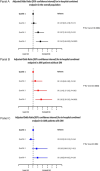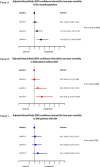Prognostic impact of admission high-sensitivity C-reactive protein in acute myocardial infarction patients with and without diabetes mellitus
- PMID: 33081810
- PMCID: PMC7576820
- DOI: 10.1186/s12933-020-01157-7
Prognostic impact of admission high-sensitivity C-reactive protein in acute myocardial infarction patients with and without diabetes mellitus
Abstract
Background: High-sensitivity C-reactive protein (hs-CRP) elevation frequently occurs in acute myocardial infarction (AMI) and is associated with adverse outcomes. Since diabetes mellitus (DM) is characterized by an underlying chronic inflammation, hs-CRP may have a different prognostic power in AMI patients with and without DM.
Methods: We prospectively included 2064 AMI patients; hs-CRP was measured at hospital admission. Patients were grouped according to hs-CRP quartiles and DM status. The primary endpoint was a composite of in-hospital mortality, cardiogenic shock, and acute pulmonary edema. Two-year all-cause mortality was the secondary endpoint.
Results: Twenty-six percent (n = 548) of patients had DM and they had higher hs-CRP levels than non-DM patients (5.32 vs. 3.24 mg/L; P < 0.0001). The primary endpoint incidence in the overall population (7%, 9%, 13%, 22%; P for trend < 0.0001), in DM (14%, 9%, 21%, 27%; P = 0.0001), and non-DM (5%, 8%, 10%, 19%; P < 0.0001) patients increased in parallel with hs-CRP quartiles. The adjusted risk of the primary endpoint increased in parallel with hs-CRP quartiles in DM and non-DM patients but this relationship was less evident in DM patients. In the overall population, the adjusted OR of the primary endpoint associated with an hs-CRP value ≥ 2 mg/L was 2.10 (95% CI 1.46-3.00). For the same risk, hs-CRP was 7 and 2 mg/L in patients with and without DM. A similar behavior was observed for the secondary endpoint when the HR associated with an hs-CRP value ≥ 2 mg/L found in the overall population was 2.25 (95% CI 1.57-3.22). For the same risk, hs-CRP was 8 and 1.5 mg/L in DM and non-DM patients.
Conclusions: This study shows that hs-CRP predicts in-hospital outcome and two-year mortality in AMI patients with and without DM. However, in DM patients, the same risk of developing events as in non-DM patients is associated to higher hs-CRP levels.
Keywords: Acute myocardial infarction; Diabetes mellitus; High-sensitivity C-reactive protein; Inflammation.
Conflict of interest statement
none.
Figures





Similar articles
-
Predictive value of CHA2DS2-VASc score combined with hs-CRP for new-onset atrial fibrillation in elderly patients with acute myocardial infarction.BMC Cardiovasc Disord. 2021 Apr 13;21(1):175. doi: 10.1186/s12872-021-01978-8. BMC Cardiovasc Disord. 2021. PMID: 33849448 Free PMC article.
-
Optimal glucose, HbA1c, glucose-HbA1c ratio and stress-hyperglycaemia ratio cut-off values for predicting 1-year mortality in diabetic and non-diabetic acute myocardial infarction patients.Cardiovasc Diabetol. 2021 Oct 19;20(1):211. doi: 10.1186/s12933-021-01395-3. Cardiovasc Diabetol. 2021. PMID: 34666746 Free PMC article.
-
Relationship of Platelet Reactivity and Inflammatory Markers to Recurrent Adverse Events in Patients with ST-Elevation Myocardial Infarction.Thromb Haemost. 2019 Nov;119(11):1785-1794. doi: 10.1055/s-0039-1695007. Epub 2019 Aug 22. Thromb Haemost. 2019. PMID: 31437861
-
Serum potassium levels and mortality of patients with acute myocardial infarction: A systematic review and meta-analysis of cohort studies.Eur J Prev Cardiol. 2019 Jan;26(2):145-156. doi: 10.1177/2047487318780466. Eur J Prev Cardiol. 2019. PMID: 31060369
-
Prognostic Role of Admission C-Reactive Protein Level as a Predictor of In-Hospital Mortality in Type-A Acute Aortic Dissection: A Meta-Analysis.Vasc Endovascular Surg. 2019 Oct;53(7):547-557. doi: 10.1177/1538574419858161. Epub 2019 Jun 27. Vasc Endovascular Surg. 2019. PMID: 31248351
Cited by
-
Admission high-sensitivity C-reactive protein levels improve the Grace risk score prediction on in-hospital outcomes in acute myocardial infarction patients.Clin Cardiol. 2022 Mar;45(3):282-290. doi: 10.1002/clc.23749. Epub 2022 Jan 23. Clin Cardiol. 2022. PMID: 35066901 Free PMC article.
-
Hs-CRP, Diabetic Status, and Adverse Events Among Patients Receiving Statin Therapy Following PCI-A Prospective Registry-Based Study.J Inflamm Res. 2025 Jul 15;18:9261-9274. doi: 10.2147/JIR.S518383. eCollection 2025. J Inflamm Res. 2025. PMID: 40687149 Free PMC article.
-
Association of physiological stress markers at the emergency department to readmission and death within 90 days: a prospective observational study.Ups J Med Sci. 2023 May 3;128. doi: 10.48101/ujms.v128.9300. eCollection 2023. Ups J Med Sci. 2023. PMID: 37223634 Free PMC article.
-
Systemic Vulnerability, as Expressed by I-CAM and MMP-9 at Presentation, Predicts One Year Outcomes in Patients with Acute Myocardial Infarction-Insights from the VIP Clinical Study.J Clin Med. 2021 Jul 31;10(15):3435. doi: 10.3390/jcm10153435. J Clin Med. 2021. PMID: 34362217 Free PMC article.
-
Cardiogenic Shock Does Not Portend Poor Long-Term Survival in Patients Undergoing Primary Percutaneous Coronary Intervention.J Pers Med. 2022 Jul 22;12(8):1193. doi: 10.3390/jpm12081193. J Pers Med. 2022. PMID: 35893287 Free PMC article.
References
-
- Brener SJ, Mehran R, Dressler O, Cristea E, Stone GW. Diabetes mellitus, myocardial reperfusion, and outcome in patients with acute ST-elevation myocardial infarction treated with primary angioplasty (from HORIZONS AMI) Am J Cardiol. 2012;109:1111–1116. doi: 10.1016/j.amjcard.2011.11.046. - DOI - PubMed
-
- Malmberg K, Yusuf S, Gerstein HC, Brown J, Zhao F, Hunt D, Piegas L, Calvin J, Keltai M, Budaj A. Impact of diabetes on long-term prognosis in patients with unstable angina and non-Q-wave myocardial infarction: results of the OASIS (Organization to Assess Strategies for Ischemic Syndromes) Registry. Circulation. 2000;102:1014–1019. doi: 10.1161/01.CIR.102.9.1014. - DOI - PubMed
-
- Marenzi G, Cosentino N, Genovese S, Campodonico J, De Metrio M, Rondinelli M, Cornara S, Somaschini A, Camporotondo R, Demarchi A, Milazzo V, Moltrasio M, Rubino M, Marana I, Grazi M, Lauri G, Bonomi A, Veglia F, De Ferrari GM, Bartorelli AL. Reduced cardio-renal function accounts for most of the in-hospital morbidity and mortality risk among patients with type 2 diabetes undergoing primary percutaneous coronary intervention for ST-segment elevation myocardial infarction. Diab Care. 2019;42:1305–1311. doi: 10.2337/dc19-0047. - DOI - PubMed
Publication types
MeSH terms
Substances
LinkOut - more resources
Full Text Sources
Medical
Research Materials
Miscellaneous

